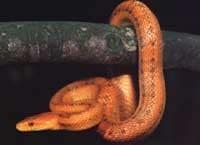-
Solomon Island skink
Scientific Name: Corucia zebrata The Solomon Island skink is the world’s largest skink, growing to a length of 72 centimetres, although nearly half this length is the tail. The skinks are sometimes called prehensile tailed skinks, or monkey tailed skinks because they use their long, agile tails to help move around in the tree canopy […]
Continue reading -
Scheltopusik
Scientific Name: Pseudopus apodus Although it might look like a snake, the scheltopusik is a legless lizard, and is sometimes known by its other name, the European glass lizard. The lizard grows to 1.35 metres and is usually tan coloured with a paler head and underbelly. It has two tiny legs, or leg stubs near […]
Continue reading -
Philippine Sailfin Lizard
Scientific Name: Hydrosaurus pustulatus Large male sailfin lizards will exceed a metre in length, much of which is tail. The most distinctive feature is the erect sail of skin situated along the lower back and base of the tail. This may be as large as 6 or 7cm high in some specimens. The function of […]
Continue reading -
Gila monster
Scientific Name: Heloderma suspectum Don’t worry, it’s not really a monster! Although Gila monsters are venomous lizards, they are so slow moving they pose little threat to humans. The only venomous lizard of the United States, the Gila monster is named after the Gila River in Arizona where is it was once common. The lizards […]
Continue reading -
Western diamond-backed rattlesnake
Scientific Name: Crotalus atrox When the western diamond-backed rattlesnake is threatened, it will shake its rattle in warning. The rattle, which is at the end of the tail, is made from keratin, and each time the snake moults, a new segment is added. Although the bite of the western diamond-backed rattlesnake has caused a lot […]
Continue reading -
King Cobra
Scientific Name: Ophiophagus hannah One of the most imposing snakes in the world, the king cobra certainly lives up to its name. With lengths in excess of 5m and a body diameter of over 12cm, it is the longest venomous species of snake. When threatened, it follows typical cobra behaviour by raising the front part […]
Continue reading -
Corn Snake
Scientific Name: Elaphe guttata A tremendously variable species comprising many subspecies or races. The usual colour has a number of red-orange blotches on an orange-grey background colour combined with a black and white checked underbelly. Some forms have no blotches and instead are orange in colour with darker stripes running along the body. It rarely […]
Continue reading -
Red-bellied Black Snake
Scientific Name: Pseudechis porphyriacus The red-bellied black snake’s head is barely distinguishable from the body as there is no obvious constricted neck area. This snake is dangerously venomous but bites are rare because it is usually a placid and fairly docile snake, preferring to enact a lengthy bluff display with flattened neck and deep hisses […]
Continue reading -
Mainland Tiger Snake
Scientific Name: Notechis scutatus A highly variable species, which does not always display the distinctive tiger stripes suggested by its common name. The body can be grey, olive-brown or almost black. In most specimens darker bands are visible. The pale areas between the bands are usually light brown or cream in colour but in some […]
Continue reading -
Lowland Copperhead
Scientific Name: Austrelaps superbus The head of the lowland copperhead is small and not obviously distinct from the body. They normally grow to a length of around a metre but on some Bass Strait islands lengths of 1.7 metres have been recorded. The body colour is quite variable, ranging from black through brown to a […]
Continue reading










